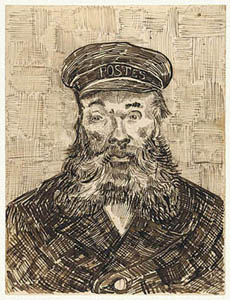• Van Gogh used lines to create this portrait. Looking closely at this work, how many different types of line can you find?
• List some adjectives you would use to describe the lines in this drawing.
• How would you describe the expression on the face of Joseph Roulin?
• What does varying the types of line used in creating this portrait do to the overall work? How does the sitter's expression compare with the type of line used?
• Van Gogh described Joseph Roulin as "a good soul and so wise and so full of feeling and so trustful." Do you think he has captured these qualities in this portrait? If so, how?
• Roulin was more than a postman to Van Gogh, he was also a friend. Why do you think the artist continued to portray him in his uniform, focusing more on his occupation than their relationship? What message does this send to the viewer about Roulin?
|
Van Gogh drew and painted many portraits of Joseph Roulin, a postal worker in Arles, in Southern France, where Van Gogh lived from 1888 to 1889. In his art and his writings, Van Gogh idealized Roulin, regarding him as both a man of the people and a sage. In addition to painting several portraits of Joseph Roulin, Van Gogh also painted Roulin's wife and their three children.
Directly facing the viewer, Roulin is pushed close to the picture surface, with one eye looking slightly wistfully to the side. Van Gogh's energetic lines describe Roulin's full beard, his facial structure, and his somewhat crooked nose. With the dark, thick lines of a reed pen, Van Gogh described the texture of the coat and cap with short animated strokes. Behind Roulin, a patchwork of nervous, intersecting lines drawn with a quill pen creates an overall surface tension, reinforcing the energy emanating from the sitter (the person depicted in the portrait) and the unsettled nature of his gaze.
In December of 1888, after an argument with his friend and fellow artist Paul Gauguin, Van Gogh sliced off a part of his own ear, offering it as a gift to a prostitute. Roulin tended to him in the aftermath of this incident, seeing him admitted to the psychiatric hospital in Arles, watching over him during his internment there, writing to Van Gogh's brother Theo to reassure him of the artist's health, and providing constant solace to the recovering painter. As Van Gogh struggled to regain his mental equilibrium, this friendship and support became even more fundamentally important for him.
About the Artist
Van Gogh decided to become an artist in 1881. Though he studied briefly in Antwerp and Paris, he was largely self-taught. He ultimately chose to live in the country, and most of his paintings capture his deep affinity for nature. His brother Theo, an art dealer, introduced Van Gogh to Paris's most advanced painters, and his work changed under the influences of Edgar Degas, Paul Gauguin, Georges Seurat, and Henri de Toulouse-Lautrec. The flatness of color and shape in Japanese woodcuts also inspired Van Gogh.
In his paintings, Van Gogh used color to express his emotions as he responded to the world. His insistence on color's expressive possibilities led him to develop a corresponding expressiveness in applying pigment. His brushstrokes of thick, opaque paint almost seem drawn. His often violently interacting colors and forms and strong expressive line influenced many artistic movements that came after him: Symbolism, Fauvism, Expressionism, and beyond.
|
